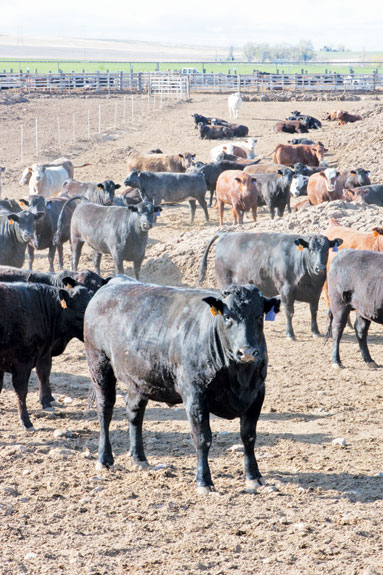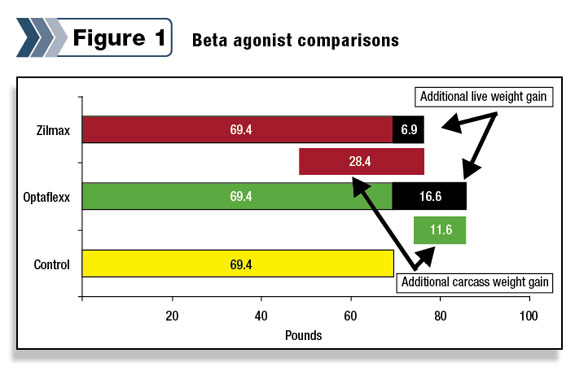Overall, every aspect of our production systems, and specifically the cattle feeding industry, needs to continually be improving in efficiency and profitability if they are to remain sustainable.
Rising feed costs, lower cattle numbers and volatile markets all make cattle feeding a very risky business.
In order to remain competitive and viable, it is essential that the cattle feeding industry utilize technology that will safely increase growth and efficiency in cattle.
For years, growth promotants and feed additives to improve health and efficiency in cattle have been available.
However, within the last decade a new class of growth promotants, beta agonists, have become available and are dramatically improving the performance and efficiency of feedlot cattle during the end of the finishing period.

Defining classes
Beta agonists are growth promotants that mimic the action of naturally occurring hormones and bind a receptor to elicit a physiological response.
Beta agonists were originally developed to help treat respiratory conditions in humans. In the case of cattle, beta agonists work by simply shifting an animal’s metabolism to more efficiently convert feed to the deposition of protein rather than fat.
This is why these products only work effectively during the late finishing phase when the animal’s natural growth curve is depositing fat rather than protein.
For finishing cattle, there are two available products: Optaflexx, introduced by Elanco Animal Health in 2004, and Zilmax, introduced by Intervet in 2007, currently a Merck Animal Health product.
These two products represent two different classes of beta agonists, class 1 and class 2. To put into perspective how these products work, it is important to understand a little about muscle biology.
In all animals, muscle cells are continually being synthesized and broken down simultaneously. Beta agonists affect either the rate of synthesis or degradation or both.
Optaflexx is a class 1 beta agonist, which increases the rate of synthesis. Increased rate of synthesis while degradation remains constant results in an increase in overall muscle.
Zilmax, a class 2 beta agonist, also increases the synthesis of muscle cells but decreases the rate of degradation of existing cells, thereby increasing muscle size through two avenues, which also explains the greater response to the class 2 beta agonist – explained below.

Choosing a target
The natural question that arises is: Which product is better? The answer depends on what the types of cattle are being fed and how they are being marketed.
The majority of scientific literature, as well as from the Freedom of Information Summaries, comparing these products head-to-head would suggest that class 1 beta agonist-fed steers had a greater live weight gain (see Figure 1) and had greater carcass quality compared with class 2 beta agonist-fed steers.
However, class 2 beta agonist-fed steers have a greater dressing percentage and carcass weight.
Heifers fed the class 2 beta agonist had a greater dressing percentage and an increased hot carcass weight compared with class 1 beta agonist-fed heifers.
However, quality grade was greater for class 1 beta agonist-fed heifers compared with class 2 beta agonist-fed heifers.
Both products increased feed efficiency, average daily gain, hot carcass weight and decreased yield grades compared with cattle not supplemented a beta agonist.
Although the reduction in quality grade was not substantial in most studies for class 2 beta agonist-fed cattle, it is important to realize that if the cattle being fed are borderline low-choice/high-select type of cattle, feeding the class 2 beta agonist may potentially decrease the amount of carcasses that grade choice.
Other comparisons
In summary, both products increase feedlot performance and add weight to the carcass compared to non-supplemented cattle.
There have been reports of decreasing quality grade using both products but a greater reduction with the class 2 beta agonist.
Additionally, there are conflicting reports in the literature about the impact of the class 2 beta agonist on tenderness.
Some reports suggest there is no effect on tenderness; however, there is enough evidence in the scientific literature to suggest that the class 2 beta agonist may decrease tenderness.
Therefore, from a marketing standpoint, the literature would suggest that the class 1 beta agonist is probably the ideal product for cattle being marketed on a live weight basis or if carcass quality grade premiums are considered.
Additional live weight gains of up to 17 pounds can be realized during the last 28 to 42 days prior to slaughter by feeding the class 1 beta agonist.
The class 2 beta agonist appears to be the ideal product for cattle sold on a carcass basis where quality grade premiums are not the goal.
The class 2 beta agonist has been reported to add an additional 21 pounds of carcass weight over class 1 beta agonist cattle during the last 20 days.
Additionally, the class 2 beta agonist has been reported to be the more profitable product (up to $20 per head) on animals that typically have higher carcass quality and lower feedlot performance, such as heifers and Holstein steers.
It is important to note that it is illegal to feed either product in amounts or times that are outside of the range indicated on the label. ![]()
PHOTO
These cattle, which were finishing with Zilmax beta agonist, can be targeted to finish with an additional 21 pounds of carcass weight over Class 1 beta agonist cattle. Photo courtesy of Progressive Cattleman staff.







